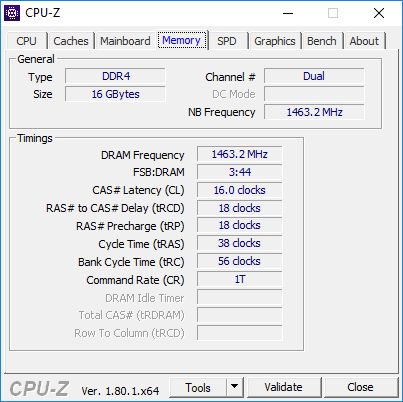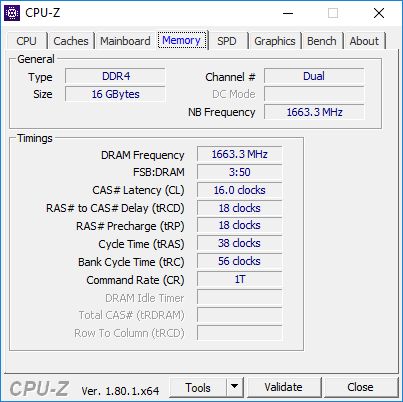Memory Scaling on Ryzen 7 with Team Group's Night Hawk RGB
by Ian Cutress & Gavin Bonshor on September 27, 2017 11:05 AM ESTMemory Straps
In the interest of achieving and obtaining consistent results, the Team Group Night Hawk RGB DDR4-3000 kit has been left at the rated latencies, which was achieved by enabling the XMP profile, and changing the memory strap/multiplier to achieve the desired frequency each time through the GIGABYTE UEFI BIOS. On Ryzen in this BIOS, due to memory strap limitations and the inability to support 100 MHz straps, the only way to run the memory at DDR4-3000 would be to run the 2933 memory strap and then adjust the base clock up from 100 MHz to 102.3 MHz. This would technically overclock the processor and in doing so, would skew the results from the other straps tested such as 2400MT/s etc.
So to keep everything on an even keel throughout, all of the settings in the BIOS except the memory settings remained at default. The memory had its XMP profile enabled, the base clock put back to 100 MHz, and different memory straps were tested with identical latency timings. All other tests were run at 16-18-18, as per the memory kit.
For the testing we are using a Ryzen 7 processor, specifically the Ryzen 7 1700. AMD's official listed support for this processor depends on the amount of memory and the memory type. The short answer to this support is that when using one memory module per channel, the Ryzen 7 1700 is designed to support DDR4-2666, but when two memory modules per channel are used, the support drops to DDR4-2400. For this test, because downclocking is easy enough, we start test from the DDR4-2400 data rate and go through the rated memory speed of the processor to the speed the memory is rated to.
We also overclock the memory beyond its rated speed. Each kit will offer different levels of overclocking performance, as it depends on the quality of the kit, the processor memory controller, and the motherboard, but we were able to push this memory kit all the way to DDR4-3333. At this speed it was stable in all our testing, and equates to a 10% increase on the rated frequency of the kit. It was interesting to see how much of an effect this speed would really manifest in our testing.
For users that are unfamiliar with this sort of image, this is the common CPU-Z tool that most professionals use to quickly probe the underlying hardware and speeds in the system. This is the main memory tab of the software, showing that we are using DDR4 in dual channel mode and have a total of 16 gigabytes. The NB Frequency, where NB historically stands for 'North Bridge', is the frequency that the Infinity Fabric is running at. In this case above, we get it running at 1663 MHz.
Below is the frequency and sub-timings for the memory itself. It shows a kit running at 1663.3 MHz, with 16-18-18 sub timings and a 1T command rate. I can already hear some of our readers with questions: why does it say the memory is running at 1663.3 MHz? I thought it was being run at DDR4-3333? So the key thing here is the difference between the frequency of the memory and how the memory works.
For a given frequency of the memory, say 1000 MHz, the system will perform 1000 million full clock cycles every second. These are full cycles, alternating from a peak voltage to a low voltage and back again within a single cycle. Modern memory, such as DDR4, is memory that runs at a Double Data Rate - this is what DDR stands for. What this means is that an action or a transfer can occur twice per cycle, usually each time the voltage alternates from peak to trough. This is also referred to as transferring on the clock cycle edges. The final result is that every cycle we get two transfers, so DDR4 at 1666 MHz is another way of saying DDR4 at 3333 mega transfers per second, or MT/s. Memory is quoted in terms of transfers per second, hence DDR4-3000 or DDR4-3333.
There is often user confusion here, with memory kits being listed as DDR4 at 3000 MHz when they mean DDR4 at 3000 MT/s (Ed: I'm pretty sure everyone on the AnandTech staff is guilty of this at some point). For this review, and any memory reviews going forward, AnandTech is going to keep consistency in how we represent numbers. Typically we will quote the MT/s value, as this is what is listed on the kit, and specifically state when we are talking about the frequency (in Hz) or the data rate (MT/s), and use 'speed' as the generic term.
In this review, we will be testing the following combinations of data rate and latencies:
- DDR4-2400 16-18-18
- DDR4-2666 16-18-18 (Ryzen 7 Supported at 1DPC)
- DDR4-2800 16-18-18
- DDR4-2933 16-18-18 (Nearest to memory kit rating)
- DDR4-3066 16-18-18
- DDR4-3200 16-18-18
- DDR4-3333 16-18-18 (10%+ overclock)












65 Comments
View All Comments
Drumsticks - Wednesday, September 27, 2017 - link
Interesting findings. I've seen Ryzen hailed on other simple forums like Reddit as having great scaling. There's definitely some at play, but not as much as I'd have thought.How does this compare to Intel? Are there any plans to do an Intel version of this article?
ScottSoapbox - Thursday, September 28, 2017 - link
2nd!I'd like to see how much quad channel helps the (low end) X299 vs the dual channel Z370. With overlapping CPUs in that space it could be really interesting.
blzd - Thursday, September 28, 2017 - link
Yes please compare to Intel memory gains, would be very interested to see if it sees less/more boost from higher speed memory.Great article BTW.
jospoortvliet - Saturday, September 30, 2017 - link
While I wouldn't mind another test there have been plenty over the last year's as the authors also pointed out in the opening of the article and the results were simple - it makes barely any difference, far less even than for Ryzen..vodka - Wednesday, September 27, 2017 - link
Default subtimings in Ryzen are horribly loose, and there's lots of performance left on the table apart from IF scaling through memory frequency and more bandwidth. You've got B-die here, you could try these, thanks to The Stilt:http://www.overclock.net/t/1624603/rog-crosshair-v...
This has also been explored by AMD in one of their community updates, at least in games:
https://community.amd.com/community/gaming/blog/20...
Ian Cutress - Wednesday, September 27, 2017 - link
The sub-timings are determined by the memory kit at hand, and how aggressive the DRAM module manufacturer wants to make their ICs. So when you say 'default subtimings on Ryzen are horribly loose', that doesn't make sense: it's determined by the DRAM here. Sure there are adjustments that could be made to the kit. We'll be tackling sub-timings in a later piece, as I wanted Gavin's first analysis piece for us to a reasonable task but not totally off the deep end (as our Haswell scaling piece showed, 26 different DRAM/CL combinations can take upwards of a month of testing). I'll be working with Gavin next week, when I'm back in the office from an industry event the other side of the world and I'm not chasing my own deadlines, to pull percentile data from his numbers and bringing parity with some of our other testing.xTRICKYxx - Wednesday, September 27, 2017 - link
.vodka is right. Please investigate!looncraz - Wednesday, September 27, 2017 - link
AMD sets its own subtimings as memory kits were designed for Intel's IMC and the subtimings are set accordingly.The default subtimings are VERY loose... sometimes so loose as to even be unstable.
.vodka - Wednesday, September 27, 2017 - link
Sadly, that's the situation right now. We'll see if the upcoming AGESA 1.0.0.7 does anything to get things running better at default settings.This article as is, isn't showing the entire picture.
notashill - Wednesday, September 27, 2017 - link
There's a new AGESA 1.0.0.6b but AMD has said very little about what changed in it.